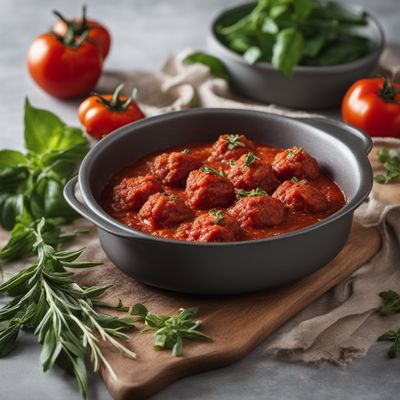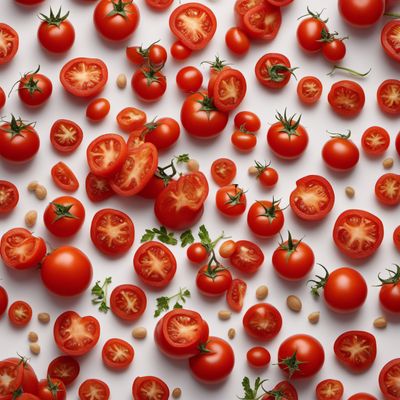
Ingredient
Preserved concentrated tomatoes
The Intense Essence of Sun-Dried Tomatoes
Preserved concentrated tomatoes are made by removing the moisture from ripe tomatoes, resulting in a concentrated form of the fruit. They have a deep red color and a chewy texture, similar to dried fruit. These tomatoes are packed with umami flavor, offering a robust and tangy taste that enhances the overall profile of any dish they are added to. Their concentrated nature allows for a more intense tomato flavor compared to fresh tomatoes, making them a favorite ingredient in Mediterranean and Italian cuisines.
Origins and history
The process of preserving tomatoes dates back centuries and was initially developed as a way to extend the shelf life of this perishable fruit. Sun-drying tomatoes was a common practice in Mediterranean countries, where the hot climate provided the perfect conditions for drying the fruit naturally. This method allowed people to enjoy the taste of tomatoes even during the off-season. Over time, the technique of preserving tomatoes evolved, leading to the creation of concentrated tomato products that are widely used today.
Nutritional information
Preserved concentrated tomatoes are a good source of vitamins A and C, as well as antioxidants. They are low in calories and fat, making them a healthy addition to various dishes.
How to select
When selecting preserved concentrated tomatoes, look for products that are made from high-quality, ripe tomatoes. Opt for brands that use natural drying methods without the addition of preservatives or artificial flavors. Check the packaging for any signs of spoilage or damage.
Storage recommendations
To maintain the freshness and quality of preserved concentrated tomatoes, store them in a cool, dry place away from direct sunlight. Once opened, transfer them to an airtight container and refrigerate to prolong their shelf life.
How to produce
Preserving concentrated tomatoes at home requires ripe tomatoes, a dehydrator, or an oven set to a low temperature. Slice the tomatoes and remove the seeds, then arrange them on a tray and dry them until they become leathery and shriveled. Store the dried tomatoes in an airtight container.
Preparation tips
Preserved concentrated tomatoes can be used in various ways. They can be rehydrated by soaking them in warm water or olive oil, which softens their texture and brings out their flavors. They can be added to pasta sauces, stews, soups, or used as a topping for pizzas and salads. Additionally, they can be blended into a paste or puree to create a flavorful base for dips or spreads.
Substitutions
Sun-dried tomatoes can be used as a substitute for preserved concentrated tomatoes, as they offer a similar intense flavor and texture.
Culinary uses
Preserved concentrated tomatoes are commonly used in pasta sauces, bruschetta, antipasti, and Mediterranean-inspired dishes. They can also be incorporated into salads, sandwiches, and savory baked goods to add a burst of concentrated tomato flavor.
Availability
Preserved concentrated tomatoes are commonly available in supermarkets and specialty food stores worldwide.
More ingredients from this category
Recipes using Preserved concentrated tomatoes » Browse all

Crispy Fried Cod with Tomato Sauce
Crispy Delight: Spanish-style Fried Cod with Tangy Tomato Sauce

Spicy Meatballs with Tomato Sauce
Fiery Polpette with Tangy Tomato Sauce

Turkish Katsudon
Istanbul Katsudon: A Turkish Twist on a Japanese Classic

Tagliatelle al ragù alla Bolognese
Elevated Tagliatelle with Haute Cuisine Bolognese Ragù

Levantine-style Macaroni Pasticcio
Savory Macaroni Delight: Levantine-style Pasticcio

Moldovan-style Affunnatielle
Savory Moldovan Delight: Affunnatielle with a Twist

Gumbo - Latvian Style
Savory Latvian Gumbo: A Fusion of Flavors

Arab-Style Lasagne
Layers of Flavor: Arab-Inspired Lasagne

Moroccan-style Lasagne
Spiced Layers of Delight: Moroccan Lasagne

Limbă cu Măsline (Romanian Olive Tongue)
Mediterranean Delight: Savory Romanian Olive Tongue

Tagliatelle al ragù alla Bolognese
Turkish-style Tagliatelle with Bolognese Sauce

Kalatusha with a Twist
Savory Delight: A Modern Twist on Kalatusha
